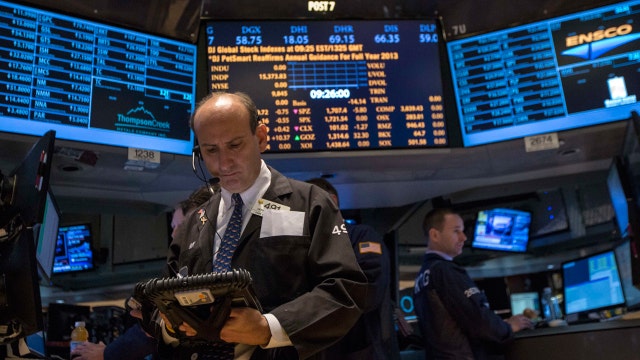Consumer Conundrum: Retail Data Highlight Week on Wall Street
It was a rough week for Wall Street.
The Dow and S&P 500 snapped a six-week win streak, ending the week down more than 3.5%, while the Nasdaq slid 4%.
Energy took the biggest hit for the week thanks to a persisting global supply glut and inventory data from the U.S. Meanwhile, consumer discretionary shares saw steep declines, while materials was the only sector in the green for the week.
Here’s what drove the action, and everything you might have missed this week in the markets.
Retail Data Diverge
On Friday, investors got the latest round of data on the American consumer. And the headline figures appear to each tell a different story.
The latest read on retail sales from the Commerce Department showed a 0.1% increase last month, compared to expectations for a 0.3% rise. Prices in September were unchanged, while forecasts called for a 0.1% rise. Excluding the volatile food and energy components at least helped put inflation in positive territory. Prices on that basis rose 0.2% for the month, but were still under expectations for an increase of 0.4%.
Meanwhile, consumer sentiment figures from the University of Michigan painted a completely different picture. The gauge rebounded in November from an unexpected tumble last month, rising to 93.1 from a final October reading of 90. Economists had forecast a smaller rise to 91.5 for November.
So if consumers were feeling confident about the economy, why weren’t they spending money?
KPMG Chief Economist Constance Hunter said that’s because the headline retail sales figures don’t take inflation into account, and that’s why it’s important to look at the figures excluding food and energy. Additionally, she said it’s important to look at what people are spending their dollars on.
“If we look at Millennials, they’re spending much, much more on experiences, than they are on physical goods and that changes the mix. The retail sales numbers are really excellent, but they don’t get the whole picture when you consider experiences,” she said.
Those are experiences like going out to eat, spending money on the gym or yoga classes, or forgoing spending money altogether to instead go hiking or spend time outdoors.
Retails Realize Change in Shopping Habits
Big-name retailers including Macy’s (NYSE:M) and Nordstrom (NYSE:JWN) were socked by disappointing third-quarter earnings, and the sector overall saw steep declines for the week.
Macy’s reported third-quarter adjusted earnings per share of 56 cents, topping expectations by two pennies. Revenue of $5.87 billion came in under forecasts for $6.09 billion, a 5.2% decline from the $6.20 billion the company earned during the same period last year. Moreover, comparable store sales for owned and licensed locations, on a year-to-date basis are down 1.7%. For company-owned stores, comp sales fell 2.2% year over year. The retailer also lowered its full-year guidance.
Nordstrom (NYSE:JWN) suffered a similar fate after a quarter in which consumers slowed their purchases. The stock continued to be punished Friday, plunging more than 16% and hitting a new 52-week low of $50.43.
The sector as a whole was clobbered on the week as consumer discretionary shares fell 4.5%. Among the decliners were Macy's, Nordstrom, Men’s Wearhouse (NYSE:MW), J.C. Penney (NSYE:JCP), and others – all shedding 10% or more over the last five trading days.
So what’s spooking the sector? A combination of factors is likely to blame, including warmer-than-usual winter weather, consumers who spend more on experiences, and a lack of conviction to buy apparel.
As Ameriprise Senior Economist Russell Price pointed out in a note Friday, most spending categories have experienced reasonable growth. Auto sales, though down a bit in October, were up 6% on the week, restaurant sales saw a 0.5% gain for the month, and furniture sales have seen a 0.4% gain in the last month.
“Clothing sales, meanwhile, were flat in the month, which may be reflective of the generally warmer than normal weather across much of the country during the month. On a year-over-year basis, sales for the category were still a respectable 4% higher,” he said.
Fed Speak Sends Wall Street in Retreat
As the Fed moves closer and closer to being willing and able to hike interest rates for the first time since the Great Recession, investors tend to spook more easily as members of the central bank make remarks about the economic situation in the U.S.
This week was no exception.
Most notable, Richmond Fed President Jeffrey Lacker on Thursday made the case for why rates should start moving higher sooner rather than later, while Chicago Fed President Charles Evans said a need for further delay is necessary to allow inflation to move closer to the Fed’s 2% target.
But perhaps the most notable hawk was St. Louis Fed President James Bullard who, in prepared remarks that day, said the U.S. was entering into an era of permanently low inflation and interest rates. He argued the seven years of near-zero rates could challenge fundamental assumption about monetary policy in the nation.
“I think there’s a good argument that this zero bound sends a very, very bad signal. It almost undermines confidence. The economy is not growing gangbusters by any means, but it’s growing strong enough that it’s able to support 25 or 50 basis points of the Fed Funds – still a very, very low interest rate,” Hunter said.
She added that it’s not all conflicting opinions at the Federal Reserve: One thing that pretty much everyone agrees on is that when rates do finally see upward movement, it should be at a gradual pace.
Week Ahead
The economic-data calendar is light for the upcoming week, though a few key reports will be in focus.
- Monday: Empire State manufacturing
- Tuesday: Consumer inflation
- Wednesday: Housing starts, FOMC October meeting minutes
- Thursday: Mid-Atlantic manufacturing, weekly jobless claims
- Friday: KC Fed survey




















